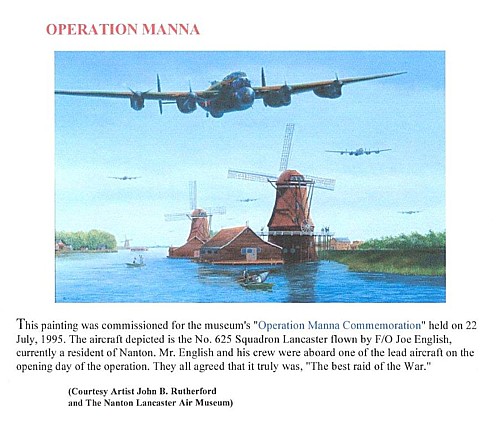Library Reference Number: 030
Operation Manna - Food from the Heavens
Regarded as one of the major food distributors in modern times, it is difficult to imagine that 20,000 people in Holland died of starvation during the German occupation in WW2. Survivors reported that they queued for hours for less and less food, when eventually unusual items such as sugar beet kept many people alive, and fried tulip bulbs were the last resort. The Netherlands had been occupied by the Germans since 10th May 1940, and to their great relief, the Dutch first heard of 'Operation Manna' on April 24th 1945 while secretly listening to banned BBC news programmes. A seventeen year old student at that time, reporting on events of April 29th 1945, wrote that there were no words to describe the emotions on that Sunday afternoon, when large numbers of food-bearing RAF Lancasters appeared to fill the sky. Alastair Lamb was an aircrew member participating in 'Operation Manna' during this period, and the following is Alistair's account of that experience.
"This highly successful operation perpetuated by RAF Bomber Command gave  life and hope to the 3.5 millions of starving Dutch people held in the German occupied area of West Holland. A total of 2,835 Lancasters and 124 Mosquito flights were made, dropping 6,672 tons of food up to 8th May
1945 when the Germans surrendered.
life and hope to the 3.5 millions of starving Dutch people held in the German occupied area of West Holland. A total of 2,835 Lancasters and 124 Mosquito flights were made, dropping 6,672 tons of food up to 8th May
1945 when the Germans surrendered.
I was a member of 15 Squadron, my Pilot was Flying Officer Jack Darlow and I was the Rear Gunner for his crew. Jack now resides in Australia (although he is French) and my Navigator was Alf Porter. Alf and I have both visited our skipper in Australia. We carried out our first food-dropping operation on 30th April '45 over Rotterdam and the flight time was 2 hours 45 minutes. The second flight was to The Hague on 2nd May '45, flight time 2 hours 35 minutes. The third operation was to Valkenburg on 7th May '45, the flight time being 2 hours 45 minutes.
The Lancaster aircraft on the first trip was LSP NG364, on the other trips we flew Lancaster LSZ 4K765 our own aircraft. LSP joined 15 Squadron on 25/11/44 survived the war, and went back to AVRO in October 1945. LSZ joined 15 Squadron in Feb '45, also survived the war being S.O.C in October '46.
Operational details: On the Rotterdam trip on 30/4/45, the load was flour, cheese, dried egg, peas, carrots & cigarettes. The drop area was 21/2 miles N.E. Rotterdam centre, it was a well-concentrated drop, with no congestion over the drop zone. Large numbers of women and children were in the drop zone despite the fact that the Germans had threatened to shoot those who had gathered to collect food. The marker flares had set fire to a house North of a square of water.
The second trip to The Hague on 2/5/45 was a very good drop with no congestion of aircraft. The load was the same as the previous drop of 30/4/45. The drop Zone was a Sports Track 2 miles North of the Hague centre. Load and conditions on the third drop were similar to the earlier trips. In the Rotterdam area, British and Dutch flags were in greater evidence than the other trips. Less number of Germans observed here than in other sorties. We were never above 500 feet, and mostly at 50 feet flying over Holland, so it was easy to observe all the activity on the ground. The Dutch people gave us a tremendous reception as we flew overhead, and we saw lots of Allied flags (banned until now) being waved along with the now famous 'V' sign. It was a great thrill to fly only 500 feet all the way from England uninterrupted, and only 50 feet above Holland.
These operations were completed before the Germans finally surrendered, and to my knowledge no aircraft were fired at. What a wonderful way to end one's operational flying - although we had to wait until August 1945 to see peace at last. I still keep in touch with my Navigator who lives in Newcastle. The mid-upper gunner lives in Carlisle, and the Flight Engineer in Canada. My skipper and family have been to see me in Stirling, and as previously mentioned I have visited them twice in Australia."
'Operation Manna' 29/4/45 - 8/5/45
The following article appeared on the news page of this website in December 2002. It gives some insight about Operation Manna from the Dutch viewpoint.
Operation Manna - View From The Ground!
A member of staff at the University of Amsterdam has commented on Alastair Lamb's "Operation Manna" story on our Branch Website (Library item 030). At the time, he was a fifteen year old youth who later qualified as a lecturer in Dentistry at the University. Our correspondant states that he distinctly remembers the planes coming over very low to drop food over Schiphol airport. He identified the dropping zone, described by Alastair as a 'sports area' north of The Hague, as probably the site of the present-day horse racecourse called Duindigt.He goes on to say men designated to collect the food were often violently sick after hastily eating food from burst containers. Through lengthy starvation, their stomachs could not cope with the sudden influx of solid food. The correspondent himself was reprimanded along with others who were sawing down trees in the street or stealing wooden logs between tram rail-tracks to put in stoves, as it had been a very severe, cold winter. Bread allocation had been a half-loaf per week, with no coal available. On the brighter side, children could be seen for many weeks later, on the canals with rafts made from large biscuit tins.

